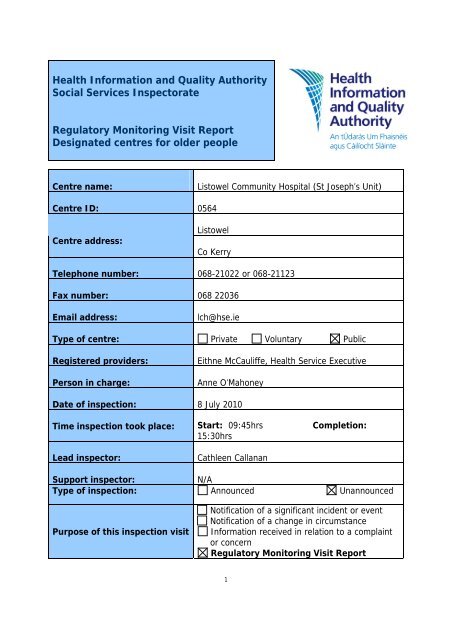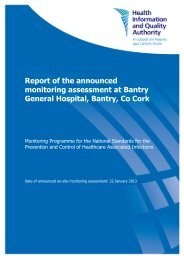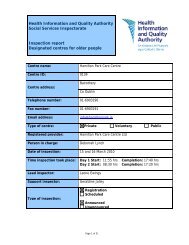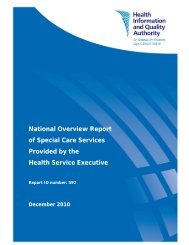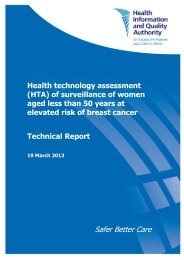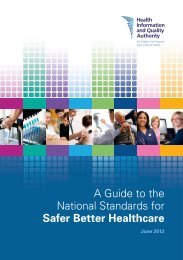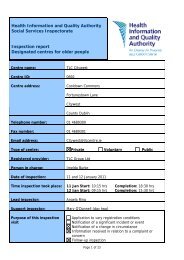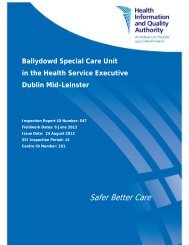Listowel Community Hospital (St Joseph's Unit) - hiqa.ie
Listowel Community Hospital (St Joseph's Unit) - hiqa.ie
Listowel Community Hospital (St Joseph's Unit) - hiqa.ie
Create successful ePaper yourself
Turn your PDF publications into a flip-book with our unique Google optimized e-Paper software.
Health Information and Quality AuthoritySocial Services InspectorateRegulatory Monitoring Visit ReportDesignated centres for older peopleCentre name:<strong>Listowel</strong> <strong>Community</strong> <strong>Hospital</strong> (<strong>St</strong> Joseph’s <strong>Unit</strong>)Centre ID: 0564Centre address:<strong>Listowel</strong>Co KerryTelephone number: 068-21022 or 068-21123Fax number: 068 22036Email address:lch@hse.<strong>ie</strong>Type of centre: Private Voluntary PublicRegistered providers:Person in charge:Eithne McCauliffe, Health Service ExecutiveAnne O’MahoneyDate of inspection: 8 July 2010Time inspection took place: <strong>St</strong>art: 09:45hrs Completion:15:30hrsLead inspector:Cathleen CallananSupport inspector:N/AType of inspection: Announced UnannouncedPurpose of this inspection visitNotification of a significant incident or eventNotification of a change in circumstanceInformation received in relation to a complaintor concernRegulatory Monitoring Visit Report1
About the inspectionThe purpose of inspection is to gather evidence on which to make judgments about thefitness of the registered provider and to report on the quality of the service. This is toensure that providers are complying with the requirements and conditions of theirregistration and meet the <strong>St</strong>andards, that they have systems in place to both safeguardthe welfare of service users and to provide information and evidence of good and poorpractice.In assessing the overall quality of the service provided, inspectors examine how well theprovider has met the requirements of the Health Act 2007, the Health Act 2007 (Careand Welfare of Residents in Designated Centres for Older People) Regulations 2009 (asamended) and the National Quality <strong>St</strong>andards for Residential Care Settings for OlderPeople in Ireland.Additional inspections take place under the following circumstances:• to follow up on specific matters arising from a previous inspection to ensure thatthe action required of the provider has been taken• following a change in circumstances; for example, following a notification to theHealth Information and Quality Authority’s Social Services Inspectorate that aprovider has appointed a new person in charge• arising from a number of events including information received in relation to aconcern/complaint or notification to the SSI of a significant event affecting thesafety or well-being of residents• for centres that have not previously been inspected within a specifictimeframe, a one-day regulatory monitoring visit may be carr<strong>ie</strong>d out tofocus on key regulatory requirements.All inspections can be announced or unannounced, depending on the reason for theinspection and may take place at any time of day or night.All inspection reports produced by the Health Information and Quality Authority will bepublished. However, in cases where legal or enforcement activity may arise from thefindings of an inspection, the publication of a report will be delayed until that activity isresolved. The reason for this is that the publication of a report may prejudice anyproceedings by putting evidence into the public domain.2
About the centreDescription of services and premises<strong>St</strong> Joseph’s <strong>Unit</strong> is part of a larger Health Service Executive district hospital. There are30 beds in the unit and 27 were occup<strong>ie</strong>d on the day of inspection.The service is offered to people over 65 including those with dementia, of whom therewere at least eleven in residence at the time of inspection. The unit also caters forpeople under sixty five with acquired brain injury, and there were two such residents onthe day of inspectionCatering and administrative services are delivered as part of the overall hospital service.There is a core staff complement of three nurses working in <strong>St</strong> Josephs who aresupplemented by staff rotating among the other parts of the hospital. At night there isone nurse and one carer on duty and one carer who is shared between <strong>St</strong> Joseph’s andthe adjacent units; support may be requested from the district hospital if required.<strong>St</strong> Joseph’s is laid out in ward-style rooms and has a communal lounge and a number ofutility and administration rooms. There are four rooms with six beds, one room with fourbeds and two single rooms. All rooms have a toilet and wash-hand basin en suite andan additional wash-hand basin in the room. There is a separate assisted shower andassisted bathroom and toilet, and an additional toilet off the communal area.While one single room is assigned to a long-stay resident, she is required to move whenit is needed for palliative care.There is a large communal room partially divided into two sections that opens throughpatio doors onto a pleasant patio area. The building is bright and pleasant.Location<strong>St</strong> Jospeh’s <strong>Unit</strong> is located on the outskirts of <strong>Listowel</strong> town in a larger hospital complex,with pleasant outdoor areas and ample parking facilit<strong>ie</strong>s.Date centre was first established: 1984Number of residents on the date of 27inspectionDependency level of Max High Medium Lowcurrent residentsNumber of residents 13 6 8 03
Management structureThe hospital matron is responsible for the overall service. The Person in Charge is aclinical nurse manager (CNM2) and in her absence a registered nurse undertakes herdut<strong>ie</strong>s. While the person in charge is not rostered for clinical dut<strong>ie</strong>s she doessupplement the staffing level on the ward to meet the needs of high-dependencyresidents and to keep abreast of residents’ needs and progress.<strong>St</strong>affdesignationNumber ofstaff onduty on dayofinspectionPersoninChargeNursesCarestaffCateringstaff1 7* 3 <strong>Hospital</strong>based* 4 in the morning and 3 in the afternoon** on sick leaveCleaningandlaundrystaffAdminstaff2** <strong>Hospital</strong>basedOtherstaff04
Summary of findings from this inspection<strong>St</strong> Joseph’s is a purpose-built facility which reflects the requirement to meet medicalneeds with limited allowance for social needs. For example, there is no dining area andresidents eat in the communal area or in their rooms. Much of the resident’s day isspent in the communal lounge and, as there is no dedicated activit<strong>ie</strong>s coordinator,opportunit<strong>ie</strong>s to promote specific programmes for residents - particularly those withcognitive impairment - are limited.Residents spoke highly of staff and the inspector observed the kindness and discretionof staff in assisting high dependency residents who, for example, required assistancewith eating.<strong>St</strong> Joseph’s has two long-stay residents - in their thirt<strong>ie</strong>s and fort<strong>ie</strong>s - who wereadmitted subsequent to an acquired brain injury and for whom the service could not beconsidered to be appropriate.Some areas of concern arose during the inspection and these are addressed in theaction plan at the end of this report. They refer to the category of resident beingaccommodated in <strong>St</strong> Joseph’s, the premises, staffing levels at night, and the level ofactivit<strong>ie</strong>s available.Comments by residents and relativesOver the course of the inspection the inspector spoke with four residents, all of whomspoke highly of the service and the staff. They made particular reference to the goodquality of the food and the opportunity to go outside and enjoy the patio area.5
GovernanceArticle 5: <strong>St</strong>atement of purpose<strong>St</strong>aff spoken to had a clear understanding of their roles and the management structure.There is a statement of purpose which does not, however, meet the requirements ofSchedule 1, in that it does not adequately identify the range of needs intended to bemet in <strong>St</strong> Josephs. This is particularly significant in v<strong>ie</strong>w of the fact that two people, intheir thirt<strong>ie</strong>s and fort<strong>ie</strong>s, have been long-stay residents, one for six and one for eightyears. These residents have very particular needs which staff in <strong>St</strong> Joseph’s do not claimto be able to meet, and reappraisal of their placements is required.Article 15: Person in chargeThere is a full-time person in charge and in her absence her dut<strong>ie</strong>s are undertaken by aregistered nurse supervised by the hospital matron.Article 16: <strong>St</strong>affingMost care staff on duty have received Further Education and Training Awards Council(FETAC) Level 5 training but as staff rotate around the hospital the skill mix can varyfrom time to time.Garda Síochána vetting has been received for staff, or is pending following application.For those staff for whom there are not three references on file – particularly staff withlong service – efforts are being made to secure the additional references.Personal Identification Numbers are held for all relevant nursing staff.The level of dependency requires significant staff input and at night in particular staffinglevels are very limited. At night there is one nurse and one carer on duty with thesupport of an additional carer, who divides her time between <strong>St</strong> Joseph’s and otherunits, and therefore has to allocate her time where she is most needed on any onenight. As staff rotate around the hospital there are only three nurses permanentlyassigned to <strong>St</strong> Joseph’s which leads to a lack of continuity of care for residents.<strong>St</strong>aff have received mandatory training and the records v<strong>ie</strong>wed by the inspector onmanual handling and fire drills were up-to-date. <strong>St</strong>aff spoken to were able to confirmtheir understanding of evacuation procedures.6
Nursing staff had completed training in dementia-specific care, the records of whichwere available to the inspector. However, as referred to above, two of the residentshave particular individual needs which staff concedes require specialist intervention andcare. One of these residents is prone to disruptive and noisy outbursts which can bedistressing for the other residents.On the day of inspection staff attended an in-house training event in the unit in theafternoon, but there were no colleagues available to replace them. While staff weretherefore still available should an emergency arise, the availability of staff on the floorwas somewhat compromised.Article 23: Directory of ResidentsThere is a directory of residents and supplementary records such as medical andphotographic records which meet the regulatory requirements outlined in Schedule 3 ofthe Health Act 2007.Article 31: Risk Management ProceduresThere is a record of incidents and near misses held in <strong>St</strong> Joseph’s which is rev<strong>ie</strong>wed andsigned off by the hospital matron. It outlines the incident and the response. There isalso a comprehensive hazard sheet outlining potential risks and hazards.In terms of emergency provision the hospital has a back-up emergency generator whichservices <strong>St</strong> Joseph’s. There is an emergency plan which at the time of inspection wasbeing updated.Article 39: ComplaintsThere is a generic HSE complains policy which also appl<strong>ie</strong>s to <strong>St</strong> Joseph’s, which isprominently displayed in the entrance area. <strong>St</strong> Joseph’s also has a dedicated complaintsbook which records a number of complaints from pat<strong>ie</strong>nts, the outcome, and theresolution of all complaints, which have been signed off by the hospital matron.Article 36: Notification of incidentsThe person in charge has notif<strong>ie</strong>d the SSI of all incidents as required by Article 36 of theHealth Act 2007.7
Resident CareArticle 9: Health CareThere are individualised care plans for all residents, a sample of which were rev<strong>ie</strong>wed bythe inspector. All residents may retain their own general practitioner (GP) but for somewho are not from the local area, a GP who is more locally based can be assigned onrequest.<strong>St</strong> Joseph’s has access to a Health Service Executive (HSE) d<strong>ie</strong>tician who visits monthly.The physiotherapist based in the hospital visits on request and administers individualtherapy, but is somewhat restricted by the absence of a dedicated treatment room.However, there is a therapy unit attached to the overall hospital service.Occupational therapy is accessed by referral from the CNM or the GP and dental andoptical services are provided as the need arises. Access to a geriatrician is on referralfrom the GP.A chiropodist and a hairdresser visit every two to three months or as required.There is no dedicated activit<strong>ie</strong>s coordinator but an art class is available every Mondayduring school term time when the teacher is available. The CNM informed the inspectorthat she tr<strong>ie</strong>s to take residents on an outing, perhaps to their local area, if the weatherpermits. However, this is dependent on suffic<strong>ie</strong>nt staff cover being available.Article 33: Ordering, Prescribing, <strong>St</strong>oring and Administration of MedicinesMedications are prescribed, stored and administered according to An Bord Altranaisguidelines. Controlled drugs are appropriately stored and signed off and medical noteshave photographic identification. <strong>St</strong> Joseph’s has a pharmacist on site as part of theoverall hospital service.Article 6: General Welfare and ProtectionThere is a HSE policy on adult protection in place, and staff spoken to by the inspectorspoke knowledgeably about elder abuse and how any suspicion should be dealt with.Training in elder abuse was documented and signed off by staff.The general welfare of two residents under the age of sixty five is of particularrelevance in that it is highly unlikely that their needs are best met in this environment.While one such resident is able to avail of some community support, the other has little8
or no community involvement or peripatetic support. In addition, the behaviour of oneof these residents seriously impinges on the quality of life of the others.Article 20: Food and nutritionResidents spoken to were happy with the range and quantity of food available, and theinspector noted that the main meal was attractively presented. Special d<strong>ie</strong>ts werecatered for and personal preferences were posted in the pantry on the ward which isused to prepare snacks and drinks. On the day of inspection a range of drinks wasavailable throughout the day.9
EnvironmentArticle 19: PremisesThe premises are clean and well lit and furnishing is of good quality. The lounge inparticular offers a pleasant v<strong>ie</strong>w and creates a feeling of spaciousness.The design and layout of the premises is based on meeting medical needs with littlereference to social needs or the need for personal privacy for residents or to meetvisitors. Therefore, there is no dedicated dining area and the communal area is limitedto the lounge. As there is no room reserved exclusively for palliative care, the inspectorwas informed by staff that the resident in that room is required to move when end-oflifecare is being administered.Article 32: Fire Precautions and records<strong>St</strong>aff have received training in fire safety and evacuation and the records of training anddrills were available for inspection. Means of escape were unobstructed and fire alarmchecks and maintenance records were up-to-date and appropriately signed off.10
Closing the visitAt the close of the inspection visit a feedback meeting was held with the person incharge, matron and the regional nurse practice development coordinator to report onthe inspectors’ findings, which highlighted both good practice and where improvementswere needed.AcknowledgementsThe inspector wishes to acknowledge the cooperation and assistance of the residents,relatives, provider and staff during the inspection.Report compiled by:Cathleen CallananInspector Manager of Social ServicesSocial Services InspectorateHealth Information and Quality AuthorityDate: 8 July 201011
Health Information and Quality AuthoritySocial Services InspectorateInspection reportDesignated centres for older peopleProvider’s response to inspection reportCentre:<strong>Listowel</strong> <strong>Community</strong> <strong>Hospital</strong> (<strong>St</strong> Joseph’s <strong>Unit</strong>)Centre ID: 0564Date of inspection: 8 July 2010Date of response: 12 October 2010RequirementsThese requirements set out what the registered provider must do to meet the HealthAct 2007, the Health Act 2007 (Care and Welfare of Residents in Designated Centres forOlder People) Regulations 2009 (as amended) and the National Quality <strong>St</strong>andards forResidential Care Settings for Older People in Ireland.1. The provider is failing to comply with a regulatory requirement in thefollowing respect:Ensuring that the <strong>St</strong>atement of Purpose meets the requirements of Schedule 1 of theHealth Act 2007.Action required:Ensure that the <strong>St</strong>atement of Purpose meets the requirements of Schedule 1 of theHealth Act 2007, with particular reference to the needs of two residents under sixty fiveyears who have been diagnosed with acquired brain injury.Reference:Health Act, 2007Regulation 5: <strong>St</strong>atement of Purpose<strong>St</strong>andard 28: Purpose and Function12
Please state the actions you have taken or are planning totake with timescales:Timescale:Provider’s response:The statement of purpose will be amended to meet Schedule 1 ofthe Health Act, 2007, specifically identifying the needs of residentsunder sixty five years diagnosed with acquired brain injury.22 October 20102. The provider is failing to comply with a regulatory requirement in thefollowing respect:Ensuring that at all times the numbers and skill mix of staff are appropriate to theassessed needs of residents, and the size and layout of the designated centre.Action required:Ensuring that at night the numbers and skill mix of staff are appropriate to the assessedneeds of residents.Reference:Health Act, 2007Regulation 16: <strong>St</strong>affing<strong>St</strong>andard 23: <strong>St</strong>affing Levels and QualificationsPlease state the actions you have taken or are planning totake with timescales:Timescale:Provider’s response:Consideration will be given to the skill mix of staff and the assessedneeds of residents (on a day to day basis).OngoingThe night duty staffing levels (skill mix) recorded was incorrect. Theexisting staff levels meet the needs of the service and is rev<strong>ie</strong>wed inaccordance with the needs of the residents.3. The provider has failed to comply with a regulatory requirement in thefollowing respect:Providing adequate private accommodation for residents.Action required:Provide adequate private accommodation so that a resident is not moved from her roomto allow it to be used for palliative care as the need arises.13
Reference:Health Act, 2007Regulation 19: Premises<strong>St</strong>andard 3: Consent<strong>St</strong>andard 4: Privacy and Dignity<strong>St</strong>andard 17: Autonomy and Independence<strong>St</strong>andard 18: Routines and Expectations<strong>St</strong>andard 25: Physical EnvironmentPlease state the actions you have taken or are planning totake with timescales:Timescale:Provider’s response:There is a plan in place to provide more private accommodation forresidents, with the conversion of one four bedded room to twosingle en suites. Work will commence on this over the next fewmonths. We do not move residents out of single rooms toaccommodate palliative care residents. A designated hospice roomis available for palliative care pat<strong>ie</strong>nts.1 October 2010Ongoing4. The provider has failed to comply with a regulatory requirement in thefollowing respect:Ensuring that adequate communal space is provided.Action required:Provide adequate communal space for dining.Reference:Health Act, 2007Regulation 19: Premises<strong>St</strong>andard 18: Routines and Expectations<strong>St</strong>andard 19: Meals and MealtimesPlease state the actions you have taken or are planning totake with timescales:Timescale:Provider’s response:The current structural layout of the hospital, does not facilitate thenumber of communal areas as outlined in the standards, however ifresources are provided every effort will be made to develop the unitin line with the environmental standards. Currently there is noOngoing28 February 201114
designated dining area. However, the proposed dining area is nowused by residents both as dining and a day area. This is based onresident’s choice. The dining exper<strong>ie</strong>nce will be rev<strong>ie</strong>wed formallyusing a satisfaction survey.5. The provider has failed to comply with a regulatory requirement in thefollowing respect:Providing opportunit<strong>ie</strong>s to participate in activit<strong>ie</strong>s appropriate to the interests andcapabilit<strong>ie</strong>s of residents.Action required:Provide opportunit<strong>ie</strong>s to participate in activit<strong>ie</strong>s appropriate to the interests andcapacit<strong>ie</strong>s of residents.Reference:Health Act, 2007Regulation 6: General Welfare and Protection<strong>St</strong>andard 2: Consultation and Participation<strong>St</strong>andard 17: Autonomy and Independence<strong>St</strong>andard 18: Routines and ExpectationsPlease state the actions you have taken or are planning totake with timescales:Timescale:Provider’s response:A rev<strong>ie</strong>w of the activit<strong>ie</strong>s provided by the hospital will be carr<strong>ie</strong>d outtaking into consideration individual capabilit<strong>ie</strong>s and capacity ofresidents.Links will be made with local community groups to increase theactivit<strong>ie</strong>s and meet the social care needs of residents.28 January 2010Immediate15
Any comments the provider may wish to make:Provider’s response:<strong>St</strong> Joseph’s unit is one part of the <strong>Listowel</strong> <strong>Community</strong> hospital, the entire unit ismanaged as one, and not as two completely separate units. The hospital needs toprovide a flexible service for the community it serves, which involves the provision ofconvalescent, palliative, respite and continuing care services. Some residents are under65, and while it is acknowledged that an older person continuing care unit is not theideal unit to accommodate these residents, there were no other appropriate optionsavailable and great efforts have been made by staff to provide additional supports fromwithin the hospital and external service providers to enhance their quality of like.The entire unit is an old building and therefore not in line with the new residential carestandards, considerable works have been undertaken in the past few years to providemore communal space within the hospital and at present there is a comprehensive planto upgrade the unit, with particular emphasis on fire protective measures. This work hasnow been tendered for and works are due to commence in the unit over the nextnumber of weeks.Provider’s name: Eithne MCauliffeDate: 12 October 201016


